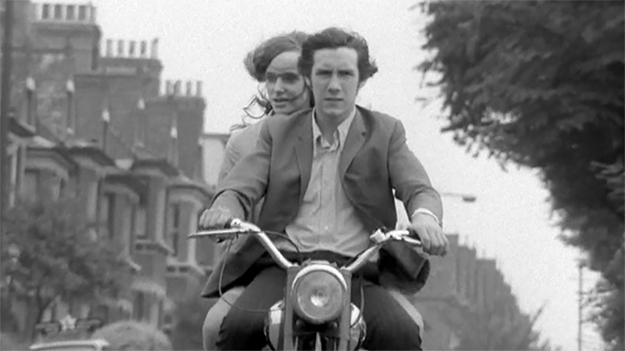Review: Bronco Bullfrog
This article appeared in the March 31, 2022 edition of The Film Comment Letter, our free weekly newsletter featuring original film criticism and writing. Sign up for the Letter here.

Bronco Bullfrog (Barney Platts-Mills, 1969)
The opening titles of Bronco Bullfrog—newly restored and now screening at Film Forum—proudly declare that the film, directed by the late British independent filmmaker Barney Platts-Mills, was “made on location in East End, London.” Rightly so, because the film’s inner-city setting—mainly Stratford, a town in East London—is its greatest asset, lending it a documentary authenticity that makes it feel like a time capsule. The impoverished postindustrial wasteland of Bronco Bullfrog—featuring desolate streets, bomb sites, and brutalist high-rises populated by teens in late-1960s “suedehead” fashions—bears little similarity to today’s Stratford. Now crowded with housing developments, noisy building sites, and monolithic shopping centers, the town underwent a drastic transformation after its selection as the site of the Olympic Village for the 2012 Games in London.
Platts-Mills––whose father was a barrister with a brief stint as a Labour Party MP––dropped out of private school at 15 to pursue acting and filmmaking, and dedicated his career to making films with and about people less privileged than himself. He made Bronco Bullfrog quickly and cheaply with nonprofessional actors, many of whom he’d met while making Everybody’s An Actor, Shakespeare Said (1968)—a documentary short about theater director Joan Littlewood and her workshop “Playbarn,” which invited local working-class youths to act out scenes drawn from their own experiences. Bronco Bullfrog employs a similarly realist approach. Platts-Mills had his cast of local teenagers improvise their own dialogue, shaping a freewheeling narrative out of their frustrations with the faltering trajectories of their lives.
In the film, Del (Del Walker), a brooding apprentice welder, trudges around Stratford’s streets looking for trouble, for distraction—really for anything that will interrupt the drudgery of daily life in his gray and monotonous hometown. A botched break-in sets the stage for the events that follow, exposing the cast as hapless teenagers with shortsighted ambitions rather than the hardmen they pretend to be. Del links up first with Bronco (Sam Shepherd), a petty criminal recently released from youth prison who lets him in on some low-level stings, and then with Irene (Anne Gooding), a girl from a nearby tower block whom he starts dating. “There’s not much to do around here, is there?” Del says to her. After a series of slice-of-life scenes that sketch out the sense of being boxed in by a lack of prospects, Del and Irene leave the inner city for the Kent countryside, attempting an ill-thought-out Bonnie and Clyde–style getaway that sees them ultimately shacked up with Bronco and stuck in a worse situation than the one they left behind.
Shot in crisp, high-contrast black and white that makes great use of the jagged lines of the East End’s crooked terrace flats, imposing tower blocks, and crisscrossing docklands cranes, Bronco Bullfrog is a grim vision of Britain at the end of the postwar economic boom. Platts-Mills’s raw, improvisational style presages the bleak social realism of Alan Clarke as much as it reflects the then-emergent kitchen-sink naturalism of Ken Loach and Mike Leigh. Yet, unlike the works of these directors, Bronco Bullfrog––despite being well-received on initial release––never found much subsequent appreciation, screening rarely and showing only twice on British television prior to its 2004 BFI DVD release and reappraisal. The original master negative had been dumped in a rubbish bin in the 1980s, so the story goes, and was saved by a forward-thinking film lab employee.
This disregard for legacy seems oddly fitting for a film fronted by down-and-outs with little in the way of hope for their future. “No money, nothing to do, think I’ll get away,” Del says at one point, but even a change of scenery leads him nowhere new. Bronco Bullfrog ends with Del backed into a corner––broke, out of ideas, and on the run from the law. At just 17, he has already exhausted all the life paths available to him. Returning in a new restoration more than a half-century after its making, Bronco Bullfrog endures as a document not just of a long-lost London, but also of an underclass rarely given space to express their disgruntlement.
Matt Turner is a writer based in London, U.K.







